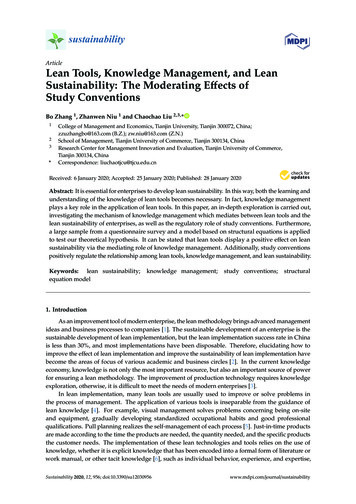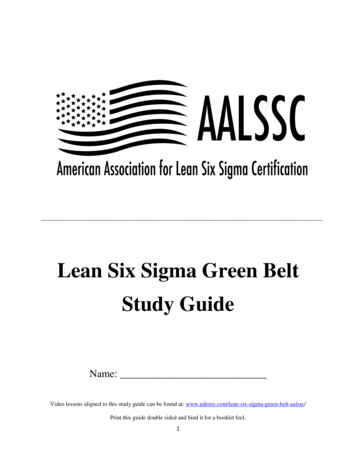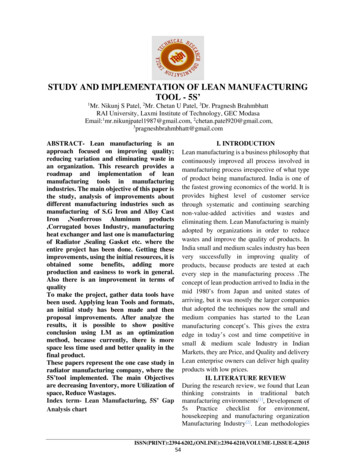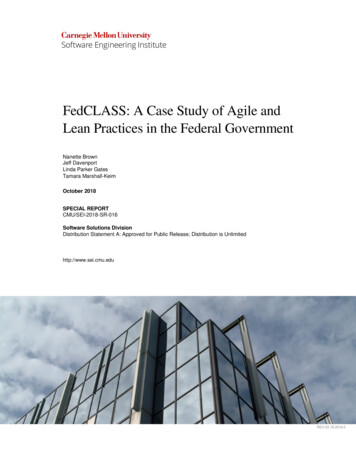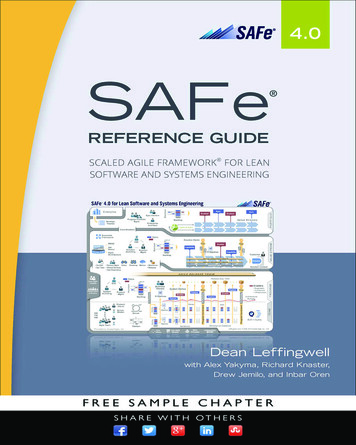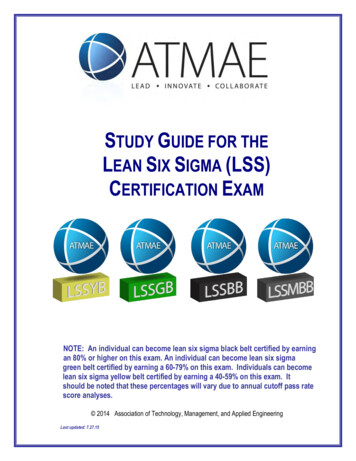
Transcription
STUDY GUIDE FOR THELEAN SIX SIGMA (LSS)CERTIFICATION EXAMATMNOTE: An individual can become lean six sigma black belt certified by earningan 80% or higher on this exam. An individual can become lean six sigmagreen belt certified by earning a 60-79% on this exam. Individuals can becomelean six sigma yellow belt certified by earning a 40-59% on this exam. Itshould be noted that these percentages will vary due to annual cutoff pass ratescore analyses. 2014 Association of Technology, Management, and Applied EngineeringLast updated: 7.27.15
TABLE OF CONTENTSContent for the ATMAE Lean Six Sigma Certification Exam . 3-5Content Determination for the ATMAE Lean Six Sigma Certification Exam . 6Belt Distinction for the ATMAE Lean Six Sigma Certification Exam . 6Composition of the ATMAE Lean Six Sigma Certification Exam . 6Sample Questions . 7-12References Used for Developing Exam Questions . 13Recommendations for Taking the ATMAE Lean Six Sigma Certification Exam . 13Answers to Sample Questions . 14ATMAE Certification Examination General Information . 15Policy . 15Examination Information . 15Individual Examinations . 15Certification after Examination . 15Program Assessment . 15Certificates . 15
CONTENT FOR ATMAE LEAN SIX SIGMA CERTIFICATION EXAMThe 12 major content areas from which the exam is comprised are as follows:ContentNumber of Questions1.Lean – Fundamentals1.17 Wastes (motion, delay, conveyance, correction,overprocessing, inventory, overproduction)1.2Gemba1.3Muda, Mura, & Muri1.45 Whys1.5Jidoka, Poka-yoke1.6Hoshin Planning (A3, PDCA)72.Lean - Value Stream Mapping2.1Purpose and Types2.2Major Parts2.3Icons/Symbols2.4Task, Subtask Diagrams, & Terminators2.5Current State & Future State Maps143.Lean – Stability3.14 Ms (man, machine, material, method)3.25S (sort, set in order, shine, standardize, sustain)3.3TPM (total productive maintenance)3.4OEE (overall equipment effectiveness)3.5Heijunka3.6Kanbans (signal, production, withdrawal)3.7Kaizen, Kaizen Blitz3.8Visual Management144.Lean - Standardized Work (Charts, Tables, etc.)4.1Production Capacity Charts4.2Standardized Work Combination Tables4.3Standardized Work Analysis Chart4.4Job Element Sheets4.5Cycle Time Table4.6Value-added Time Report Log4.7Process Master Document4.8Document Tagging Worksheet4.9Distribution Report6
ContentNumber of Questions5.Lean – Production (Calculations)5.1Lead Time & Calculations5.2Cycle Time Calculations5.3Inventory Types and Calculations5.4Calculating Takt Time5.5Calculating Pitch5.6Production Matrix5.7Transactional Matrix5.8Operators per Process Calculations5.9On time Delivery Calculations (OTD)166.Six Sigma – Project Management86.1Project Charter6.2Project Deliverables6.3Selecting Projects6.4Building a Business Plan6.5Cost Benefit Analysis6.6Return on Investment (ROI)6.7Net Present Value (NPV)6.8Internal Rate of Return (IRR)6.9Key Performance Indicators (KPIs)6.10Understand Define, Measure, Analyze, Improve, & Control (DMAIC)7.Six Sigma – Team Management7.1Types of Teams7.2Team Members7.3Team Tools7.4Decision Making Processes48.Six Sigma – Design Phase Statistics8.1Problem Solving Strategy Y f(x)8.2Voice of the Customer (VOC)8.3Defining a Process8.4Critical to Quality (CTQ)8.5Cost of Poor Quality (COPQ)8.6Pareto Analysis (80:20 rule)8.7DPU, DPMO, FTY, RTY8
Content9.Number of QuestionsSix Sigma – Measure Phase Statistics9.1Cause & Effect Diagrams9.2Process Mapping, SIPOC9.3Failure Modes & Effects Analysis (FMEA)9.4Descriptive Statistics9.5Normal Distributions & Normality9.6Graphical Analysis9.7Precision & Accuracy9.8Gage Repeatability & Reproducibility9.9Variable & Attribute MSA9.10Capability Analysis9.11Measuring Scales9.12YX Diagrams2610. Six Sigma – Analyze Phase Statistics10.1Inferential Statistics10.2Root Cause Analysis10.3Multi-Vari Analysis10.4Sampling Techniques & Uses10.5Central Limit Theorem10.6Hypothesis Testing with Normal Data10.7Hypothesis Testing with Non-Normal Data1411. Six Sigma – Improve Phase Statistics11.1Simple Linear Regression11.2Multiple Regression Analysis11.3Designed Experiments11.4Full Factorial Experiments11.5Fractional Factorial Experiments212. Six Sigma – Control Phase Statistics12.1Control Charts (SPC, EWMA, CUSUM)12.2I-MR Chart12.3Xbar-R Chart12.4U Chart12.5P Chart12.6NP Chart12.7X-S chart5NOTE:Individual content mastery data of examinees can be provided for all of the 88 subsections listedunder the 12 major content areas for programs using this exam for assessment purposes.
Content Determination for the ATMAE Lean Six Sigma ExamThe content for this exam was derived by surveying certified lean six sigma black belts from across theUnited States from a wide range of companies and government entities that varied in size, productsproduced, and services provided. It should be noted that all the information on this exam is important,however, certain content areas are used more often on the job than others, thereby, those content areasreceived more emphasis on this exam. This was noted by the order the content areas were ranked and bythe comments from those surveyed.Belt Distinctions for the ATMAE Lean Six Sigma ExamDepending upon the grade earned by the examinee taking this exam, an examinee can earn one of threedifferent belt distinctions. If the examinee earns approximately a 40-59% on the exam (cutoff passingscores are evaluated annually), then he or she will be classified as a Lean Six Sigma Yellow Belt. Anexaminee earning a score of 60-79% will be classified as a Lean Six Sigma Green Belt. All examineesearning a score of 80% or higher on the exam will be classified as a Lean Six Sigma Black Belt.Individuals who would like to be classified as Lean Six Sigma Master Black Belts will have to submit a leansix sigma project that they have completed as well as one from an individual that they are assisting withon a project. All projects must be preapproved by the ATMAE Certification Board before being initiated.Candidates will have up to three years to complete the projects once final approval is given by the ATMAECertification Board. An additional fee is charged for reviewing the projects. In addition, all projects musthave the approval by the candidate’s supervisors and a financial statement must be included with thesubmission of the project. Further details regarding project format can be obtained by contacting theATMAE office.Composition of the ATMAE Lean Six Sigma ExamThe ATMAE Lean Six Sigma exam covers 12 main content areas and is further divided into 88subcategories. The exam is divided into two main parts: the first part consists of 100 multiple choicequestions that are worth 1 point each. The second part of the exam is composed of 25 multiple choicequestions that require an examinee to solve a production or statistical problem that may take severalminutes. Because of the time constraints, these questions are worth 4 points each. Therefore, each of theparts is worth 100 points and the combined scores from these two parts are used to calculate theexaminee’s final score on the exam. A printout of how well the examinee performed on each of the 12main areas and 88 subcategories is emailed to them once all their fees have been paid. The emailedprintout is a useful instrument to the examinee for reviewing any areas of weakness in case he or shewould like to retake the exam to earn a higher belt distinction. Textbooks from which the content for thisexam was developed from are listed after the sample questions section of this study guide.
Sample Questions from Some of the Sections of the ExamNOTE: The following questions are just a sample of the questions that you may find on the exam. Thesequestions were either used on previous versions or did not meet the psychometric standards required foraccrediting the exam. At any rate, these questions provide the examinee with a general idea as to thebreadth of content covered on this exam, however, all the content areas are not represented with thesesample questions.1. Which of the following is true? (Best answer)A. A VSM is often difficult to follow for shop floor personnel.B. A VSM is only a preliminary tool for restructuring labor and management.C. A VSM is a tool to improve product quality.D. A VSM enables all stakeholders of an organization from the ground up to easily visualizeand understand the process.2. How are similar products usually grouped when value stream mapping?A. By having a commonality of 70% or moreB. By having a commonality of 50% or moreC. By having similar profilesD. By sizeE. By weight3. How should you check a current state value stream map?A. Ask top management how product flowsB. Ask shop floor personnel how product flowsC. The “team” checks the mapD. Use existing diagrams of flowE. Follow the value stream on the shop floor4. When drawing a production matrix, where are the products listed?A. on the top of the spreadsheetB. on the far right of the spreadsheetC. on the far left of the spreadsheetD. on the bottom of the spreadsheetE. they are not listed on the spreadsheet5. Where does the supplier box belong on a value stream map?A. top right corner of paperB. top left corner of paperC. top and middle of paperD. top right or top left corner of paperE. none of these
6. How many operators are required if the takt time is 60 seconds and operation 1 takes 55seconds, operation 2 takes 75 seconds, operation 3 takes 86 seconds, operation 4 takes 95seconds? Do NOT round up or down.A. 3B. 4C. 5D. 6E. none of these7. What is used when there are internal problems with the value stream?A. safety inventory B. buffer inventory C. customer inventoryD. none of these8. What type of error occurs when the null hypothesis is rejected when it is true?A. Type IB. Type IIC. Type IIID. Type IV9. Who is the person responsible for monitoring the meetings and takes the minutes for a teamworking on a lean six sigma project?A. team facilitatorB. team leader C. team championD. time keeper & scribe10. What could be impacted by GD&T in regards to the 7 wastes of a lean organization?A. motionB. conveyanceC. correctionD. overprocessing11. Fifty pairs of shoes are to be sold in 500 days. What would be the takt time for producing theseshoes?a. .1b. 10c. 100d. 112. Nine purchase orders are to be processed in 780 minutes. The takt time would be?a. 87b. 80c. 85d. 8813. The takt time is 11 minutes and the cycle time for a particular step is 40 minutes, how manypeople are required?a. 3.6b. 3c. 4d. 4.614. What measurement scale is this an example of: Dollars?a. Ratiob. Nominalc. Ordinald. Interval15. Continuous or variables data result from characteristics that are counted?a. Trueb. False16. What is the sample standard deviation of the following data set: 10, 14, 17, 20?a. 4b. 18.25c. 18d. 4.2717. If there are 8 bolts that are US spec and 6 bolts that are short, what is the probability of selectingeither a US spec bolt or a short bolt? (hint: P(US U Short))a. .5714b. .1234c. .9999d. .0714
18. If there are 52 cards in a deck, 4 kings and 13 diamonds. What is the probability of selecting acard that is both a king and a diamond? Hint: P(K Uand this is a nonmutually exclusiveevent)a. .3269b. .7100c. .3077d. .947319. The area under the standard normal curve between 1.19 standard deviations and 2.14 standarddeviations is?a. .1008b. . 1040c. .1254d. .1170STANDARD NORMAL DISTRIBUTION .51.61.71.81.922.12.220. A batch process produces cigars with a specification on the dextrose equivalent (DE) of 7.00 to7.10. The DEs are normally distributed, and a control chart shows the process is stable. Thestandard deviation of the process is .032. The DEs fr
27.07.2015 · Composition of the ATMAE Lean Six Sigma Exam The ATMAE Lean Six Sigma exam covers 12 main content areas and is further divided into 88 subcategories. The exam is divided into two main parts: the first part consists of 100 multiple choice questions that are worth 1 point each. The second part of the exam is composed of 25 multiple choice


